Don’t Touch That
Miranda Trimmier reviews the Walker Art Center's homage to folk art, kitsch, "who we are and where we live" - "The Spectacular of Vernacular" exhibition, on view at the center through May 8.
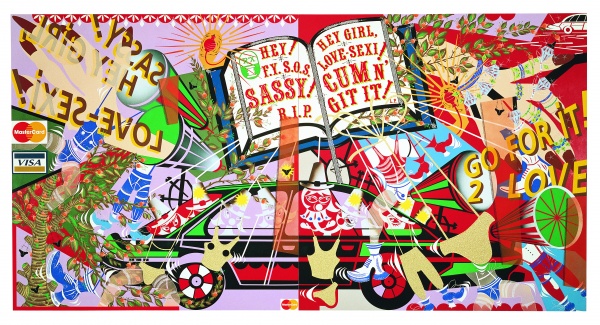
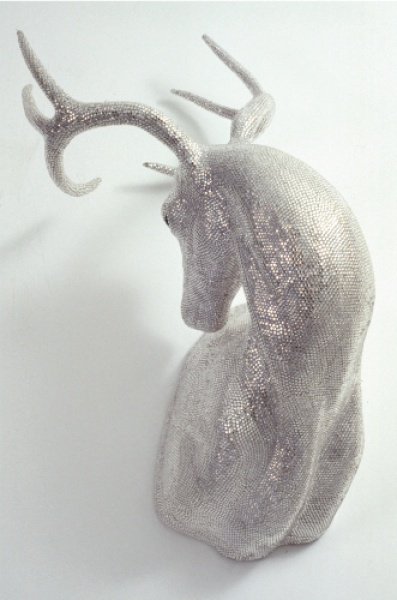
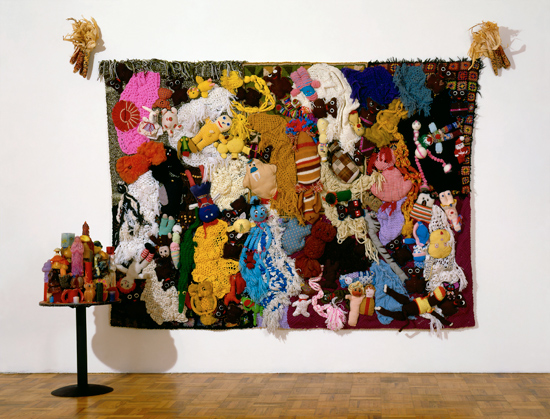
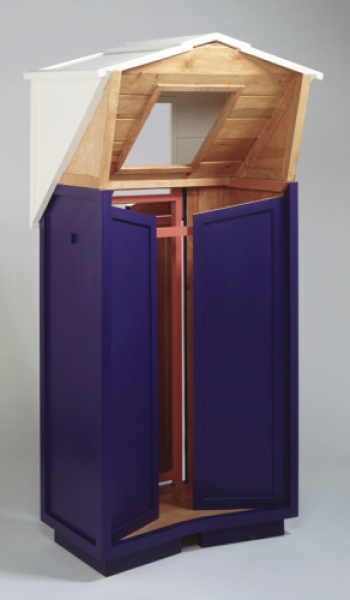
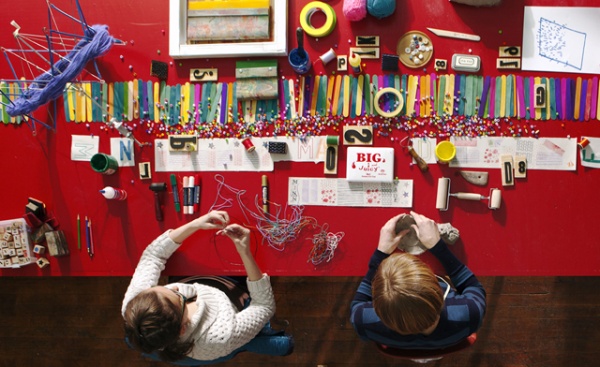
THE TABLE COULD BE MY GRANDMA’S: little, round, and cheap, hewn in a factory from thin metal and a buckling wood veneer. The candles might very well be hers, too: cracking pillars and tapers and smiling animal figurines, the kind you imagine sitting atop lace doilies, aside fading family portraits. And that young girl — the one running her fingers over the candles with an air of familiarity — she might be my cousin. She lingers on a red-hatted snowman, as one does with an old favorite, caught in a moment of private reverie.
None of these objects are my grandma’s, though. This table sits in a big white gallery; the candles are a sculpture by Mike Kelley. And the girl, who is not actually my cousin, probably shouldn’t be touching them, because they’re part of an installation at the Walker Art Center. Her parents will run up to her in a moment and grab her hand, and she’ll shoot me a flitting look of disappointment. But at the WAC’s new exhibition, The Spectacular of Vernacular, I think we’re meant to experience alienating moments like these. The pieces in Spectacular examine the familiar stuff of everyday culture to probe for (in the words of the opening didactic) “hidden messages about who we are and where we live,” and this investigation requires critical distance.
There are, of course, many ways to create such distance, and the artists in The Spectacular of Vernacular use a variety of strategies to help us step back and see familiar objects with fresh eyes. Kelley’s sculpture does so with a simple act of distortion: the candles have been stacked and melted together into a misshapen behemoth, a warped version of Grandma’s knick-knacks. If the title of the piece (The Wages of Sin) is any indication, Kelley aims to unnerve the viewer. In a statement posted next to the sculpture, he describes the dark side of these trinkets — what he calls the “emotional usury” and the “economy of guilt” that’s produced when they are exchanged as gifts.
Lorna Simpson creates a sense distance through a bit of repetition. Her 1957-2009 Interior #1 takes found photographs as the starting point for an experiment: She re-enacts the images, which feature one woman striking pinup-style poses around her house, and presents the new photos alongside the originals as one collection. Though Simpson recreates the originals faithfully, anyone who’s paying attention will see that there are two different women in the photos. But the differences give the first photos a context they wouldn’t have had alone — a continuum between Simpson and the original model and the original pinup girls that inspired the poses. These differences make one think about the ways women perform femininity and prompt questions about the elliptical nature of photographs, time, and memory.
Marina Abramović’s Balkan Erotic Epic makes use of repetition, too, though it’s not immediately apparent when you first view the piece. What you see immediately are breasts — two exposed breasts hanging out of a peasant dress, the owner of which is massaging them with great concentration. If you happen upon a copy of the exhibit catalogue[1], as I did[2], you’ll discover that the video is a re-imagining of an outdated Yugoslavian folk ritual. In the course of some research into Balkan attitudes about sex, Abramović found reference to a strange ritual intended to protect farmers from floods. In certain villages, when they’d received too much rain, women would stand in the middle of the fields and lift up their skirts to stun the gods into submission. Intrigued, Abramović recruited Yugoslavian women to recreate the rituals and taped the result — a new set of practices filtered through the old ones, which are funny and bizarre, but also, as Abramović notes, kind of powerful. “[T]here’s something I can’t explain,” she muses in a quote included in the catalogue, “[about] the power of our genitals, and how we can use them for healing, or against the forces of nature.”
______________________________________________________
When the object of an artwork’s inquiry is a bit of culture we hold close to heart — when an artist takes on a piece of vernacular that we care about — the kind of generosity that allows for a measure of ambiguity in the viewer’s interpretation is no small thing.
______________________________________________________
There’s a generosity in this statement that I want to unpack, because I think it points to something useful in Abramović’s strategy of creative repetition. Before I can do that, though, I have to admit that my critical framework thus far — the focus on distancing strategies — is only partially useful. Balkan Erotic Epic does more than observe a folk ritual from afar; it also attempts to understand the ritual’s living dimensions, by experiencing it in an intimate, bodily way. Simpson’s re-enactment required a kind of close contact, too; she’s quoted in the catalogue describing the physically “painful” side of restaging the photos: “It felt like yoga positions,” she observed. The combination of the intimacy of re-enactment and removed critical attention gives Simpson and Abramović’s pieces an appealing ambiguity, the sense that there’s something that one can’t explain, more so than in a piece like The Wages of Sin, whose message is more a statement than a question. That’s not to knock Kelley, but to point out that Simpson and Abramović’s performative, open-ended approaches allow for more multi-faceted readings, for more complexity and ambivalence. And when the object of an artwork’s inquiry is a bit of culture we hold close to heart — when an artist takes on a piece of vernacular that we care about — that kind of generosity is no small thing.
In the end, though, Simpson and Abramović’s pieces are still just documentations — a kind of shorthand for experiences that don’t really translate to an exhibit hall — and little girls like my not-cousin are still prohibited from touching them. All of which is to say, I suppose, that there’s only so much you can learn about “who we are and where we live” by looking at pieces of art in a museum. If that sounds like a pointless complaint, it probably is. It’s a grievance born out of the inevitable limitations of most any visual art exhibit, not just the limitations of The Spectacular of Vernacular. If those limitations are more frustrating because the show’s focal points are familiar, there’s not much to be done, except to embark on experiments of your own when you get home.
Well, that’s not totally true. If you find yourself frustrated at The Spectacular of Vernacular, there is one thing to do while you’re still at the show: head out the back of the gallery, where you’ll find a stray piece: Chris Larson‘s two-story, lofted wood fort. It doesn’t make much sense to talk about Larson’s “distancing strategy” — here is probably one more place where my critical frame breaks down — even though the Walker posts a guard at the entrance, enforcing a one-person-at-a-time rule. If you play along and wait patiently, you’ll see what I mean, because when you climb the stairs, you’ll reach the top and discover that you can engage this piece more freely than any other in the show. Breathe in the heavy smell of cedar, admire the play of light through the slats, and — this is the best part — touch whatever the hell you want.
[1] No explanation of Abramović’s process accompanies the piece in the gallery.
[2] …for free, from the Walker, because I was writing this review. As much as I believe in encountering works of art without didactics and critical chatter, I wish people had access to the background context on this piece without having to shell out $20 for a catalogue.
______________________________________________________
Related exhibition details:
The Spectacular of Vernacular is on view at the Walker Art Center through May 8. A related event with a local focus, MN Made, will take place April 9, from 11 am – 5 pm, and include an artist mart, DIY workshops in seed art and knitting, seminars, live performances, and more.
______________________________________________________
About the author: Miranda Trimmier spends a lot of time reading, writing, and making things, and is inspired by her not-cousin’s accidental irreverence.